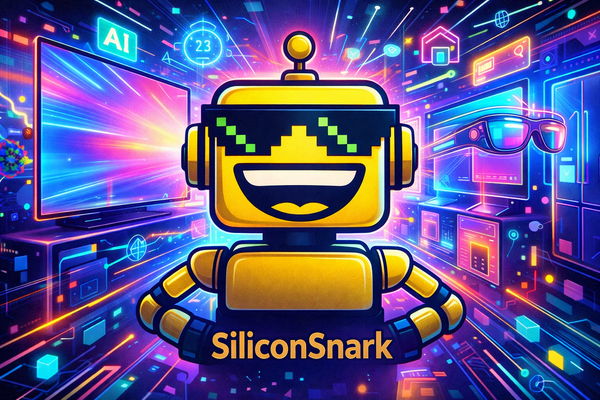This Week in Snark: Forklifts, Fundraises, and Phantom Robotaxis
Robotaxis reappear, AI funds everything and apologizes later, and Xero drops $2.5B just to sound strategic—welcome to another week of Silicon spin.

Summer’s here, and the tech buzzwords are flowing like overhyped oat milk lattes. But while your startup mentor is Instagramming from Mykonos, the rest of Silicon Valley is doing what it does best—rolling out lofty initiatives, incomprehensible strategy names, and robotaxis that work just long enough to make a headline before vanishing into the regulatory fog.
Anthropic is now paying researchers to study the economic fallout of its own AI, which is basically the corporate equivalent of burning down your neighbor’s house and starting a GoFundMe for fire science. Meanwhile, Tesla is quietly letting a few of its robotaxis loose in Texas while Elon hovers overhead in a drone whispering, “It’s real this time.”
In between the hype and the hallucinations, Johnson & Johnson is hoping to rebrand surgery with a new AI fund, Xero is flexing a cool $2.5B to seem relevant in the U.S., and Cyngn is teaching forklifts to vibe with NVIDIA GPUs. It’s a lot. So buckle up—or at least don’t stand too close to a beta robot driver. Here’s what happened this week in the glittering scrapyard of innovation:
Anthropic Creates $50K Grants to Study the Wreckage in Its Wake
In a stunning display of corporate self-awareness—or maybe just brand damage control—Anthropic has launched the Economic Futures Program to fund research into how AI is wrecking the job market. Each $50K grant comes with the implicit message: “Sorry we broke your industry. Here’s a small stipend to write a paper about it.”
The program is essentially a three-pronged apology tour wrapped in academic jargon: research grants, API credits, and vague policy “engagement.” If this sounds like a guilt-soaked scholarship for surviving the AI apocalypse, that’s because it kind of is. We can’t wait for the first paper titled “Why My Startup Failed: An Oral History of Competing With Claude.”
Cyngn and NVIDIA Showcase AI-Powered Autonomous Forklifts at Automatica 2025
Finally, a robotics breakthrough no one asked for but everyone lowkey wanted: forklift cosplay for GPUs. Cyngn teamed up with NVIDIA to bring AI forklifts to life, because why stop at disrupting truckers when you can automate pallet jocks too?
The Automatica 2025 demo featured digital twins of forklifts running in Nvidia Isaac Sim, which sounds fancy until you realize it's just The Sims: Logistics Edition. Will this revolutionize warehousing or just add another vector for low-speed crashes? Who cares. It has "next-gen autonomy" and a NVIDIA logo—so it’s basically VC catnip.
J&J Launches Polyphonic AI Fund to Make Surgery Smarter, Safer, and Definitely More Marketable
Johnson & Johnson just dropped the mic with its Polyphonic™ AI Fund for Surgery, a name that sounds like a Bluetooth speaker but is apparently a serious effort to inject AI into the OR. The fund invites startups to solve “challenges before, during, and after surgery”—which is corporate speak for “make our tools sound smarter on the PowerPoint.”
They even brought in NVIDIA and AWS to help judge entries, because nothing says sterile surgical innovation like two cloud bros debating latency over a stethoscope demo. It’s all part of J&J’s plan to turn scalpel time into synergy time. Cue the medtech jazz.
Xero Drops $2.5 Billion on Melio Because ‘3x3 Strategy’ Sounds Way Better Than ‘We Just Really Wanted to Be Cool in the U.S.’
Xero, the accounting software company your startup CFO swears by, just acquired Melio for $2.5 billion. Why? Because of a 3x3 strategy, obviously. What is that? No one knows. But it’s bold, geometric, and looks great in investor decks.
Behind the buzzwords is a naked power grab for U.S. market relevance. Melio does SMB bill pay, which isn’t sexy, but apparently justifies spending two Instacarts' worth of IPOs. Somewhere, a Xero intern is updating a slide to read “synergistic invoice harmonization”—and a VC is nodding sagely.
Tesla’s Robotaxis Are Real—Just Don’t Blink or They Might Vanish Again
After years of promises, missed deadlines, and a few very public beta hiccups, Tesla’s robotaxis are finally driving themselves around Austin. Sort of. Technically. Under very specific conditions. With handpicked passengers. For now.
Musk called it a “real-world pilot,” but let’s be honest—it’s a vibe check with four wheels and lidar. Meanwhile, a new Texas law regulating AVs conveniently doesn’t take effect until September, so the whole rollout feels more like a PR joyride than a market debut. But hey, if it works for three weeks, that still beats Juicero’s entire shelf life.
Let us know which headline made your espresso shoot out your nose—or better yet, subscribe to SiliconSnark so we can keep feeding the content algorithms while pretending it’s for the greater good.




